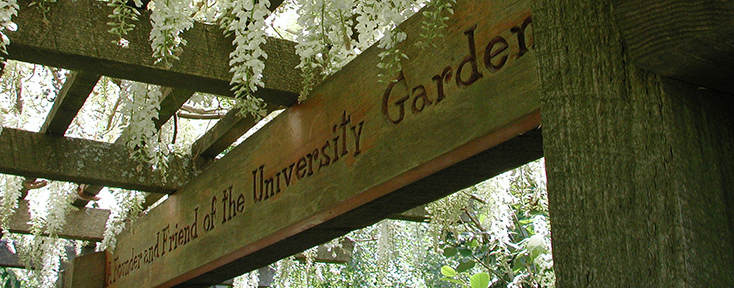History

The university gardens were developed when, in 1974, the estate of Mrs. Jeanne Buchanan Simpson of Cowichan Lake was left to the university. She and her husband George, beginning in the 1920s, built up a notable collection of Rhododendron species at their Lake Cowichan home. Many plants were grown from seed obtained directly or indirectly from famous plant explorers of the day. Theirs was the largest collection in British Columbia.
The Buchanan Simpson's gift transferred to the university the responsibility for the well-being of a significant collection of a popular genus among Victoria gardeners. The university decided to move many of the rhododendrons to the campus, where they would form the nucleus of a new garden at the south end of the campus.
Several local rhododendron enthusiasts were asked to help plan and develop the gardens. This group formed the Friends of the University Gardens. They and their successors have continued to guide and finance the development of the gardens.
The Simpson plants were up to 50 years old and presented a challenge to the transplanters. After the death of her husband, Mrs. Simpson had been unable to maintain the garden properly. The rhododendrons had to struggle for survival without the benefit of summer watering and in competition with the invading "jungle." You will recognize these sometimes distorted giants in the garden today. Most of them are R. decorum or R. fortunei. In their growth-form they resemble these species growing in their native mountains of Asia.
The gardens today
By 1988, it had become apparent that the soil conditions in the first section were not suitable for rhododendrons. These conditions proved impossible to improve. That summer it was decided to move the rhododendrons from the wetter areas to a nearby space that was well drained and attractively wooded. The move was begun in September. In three months the site had been prepared and more than three hundred rhododendrons, companion shrubs and trees had been transplanted.
The move was a major task undertaken jointly by Anthony James, curator of the university gardens, and Dr. Herman Vaartnou, a valuable member of the garden friends. That portion of the new garden area is now complete and the area the plants were moved from has been replanted with trees and shrubs more suitable to the moist conditions. About a hundred rhododendrons were left inside Ring Road. They were on better drained locations and were thriving.
The collection now includes more than 200 rhododendron species and azaleas along with an extensive planting of hybrids, most of them of early origin. The accession list includes about 1600 entries for trees and shrubs. All are catalogued and identified by a number that refers to a master list.
This is a garden in active growth. Rhododendrons may be seen in flower from mid-January until late June, as well as extensive collections of spectacular perennials from July onwards.
Companion plants such as Garrya, Chimonanthus, Hamemalis, Mahonia and Eucryphia extend the season through most of the year.
